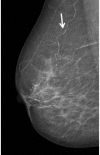The association of breast arterial calcification and metabolic syndrome
- PMID: 25627997
- PMCID: PMC4286665
- DOI: 10.6061/clinics/2014(12)09
The association of breast arterial calcification and metabolic syndrome
Abstract
Objectives: We investigated the relationship between metabolic syndrome and breast arterial calcification detected via mammography in a cohort of postmenopausal subjects.
Methods: Among 837 patients referred to our radiology department for mammographic screening, 310 postmenopausal females (105 patients with and 205 patients without breast arterial calcification) aged 40 to 73 (mean 55.9 ± 8.4) years were included in this study. The groups were compared with respect to clinical characteristics and metabolic syndrome criteria. Univariate and multivariate analyses identified the factors related to breast arterial calcification.
Results: Age, postmenopausal duration and the frequencies of diabetes mellitus, hypertension and metabolic syndrome were significantly higher in the subjects with breast arterial calcification than in those without (p<0.05). Multivariate analysis indicated that age (OR=1.3, 95% CI=1.1-1.6, p=0.001) and metabolic syndrome (OR=4.0, 95% CI=1.5-10.4, p=0.005) were independent predictors of breast arterial calcification detected via mammography. The independent predictors among the features of metabolic syndrome were low levels of high-density lipoproteins (OR=8.1, 95% CI=1.0-64.0, p=0.047) and high blood pressure (OR=8.7, 95% CI=1.5-49.7, p=0.014).
Conclusions: The likelihood of mammographic detection of breast arterial calcification increases with age and in the presence of hypertension or metabolic syndrome. For patients undergoing screening mammography who present with breast arterial calcification, the possibility of metabolic syndrome should be considered. These patients should be informed of their cardiovascular risk factors and counseled on appropriate lifestyle changes.
Conflict of interest statement
No potential conflict of interest was reported.
Figures
References
-
- Grundy SM, Cleeman JI, Daniels SR, Donato KA, Eckel RH, Franklin BA, et al. Diagnosis and management of the metabolic syndrome: an American Heart Association/National Heart, Lung, and Blood Institute Scientific Statement. Circulation. 2005;112(17):2735–52. - PubMed
-
- Isomaa B, Almgren P, Tuomi T, Forsen B, Lahti K, Nissen M, et al. Cardiovascular morbidity and mortality associated with the metabolic syndrome. Diabetes Care. 2001;24(4):683–9. - PubMed
-
- Ford ES, Giles WH, Dietz WH. Prevalence of the metabolic syndrome among US adults: findings from the Third National Health and Nutrition Examination Survey. JAMA. 2002;287(3):356–9. - PubMed
-
- Sipila K, Koivistoinen T, Moilanen L, Nieminen T, Reunanen A, Jula A, et al. Metabolic syndrome and arterial stiffness. The health 2000 survey. Metabolism. 2007;56(3):320–6. - PubMed
-
- Screening for breast cancer: U.S. Preventive Services Task Force recommendation statement. Ann Intern Med. 2009;151(10):716–26. - PubMed
MeSH terms
LinkOut - more resources
Full Text Sources
Other Literature Sources
Medical



